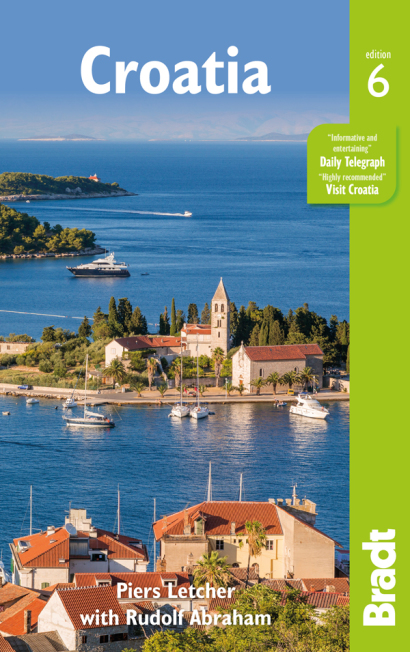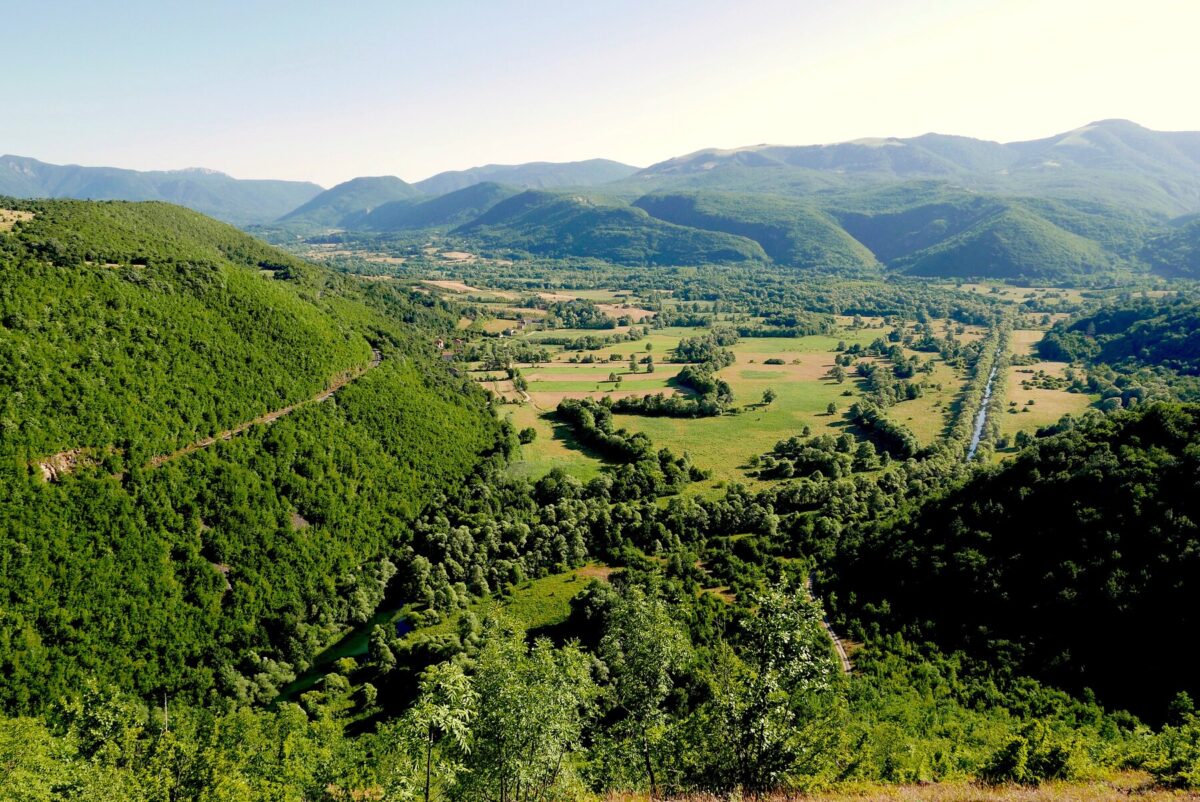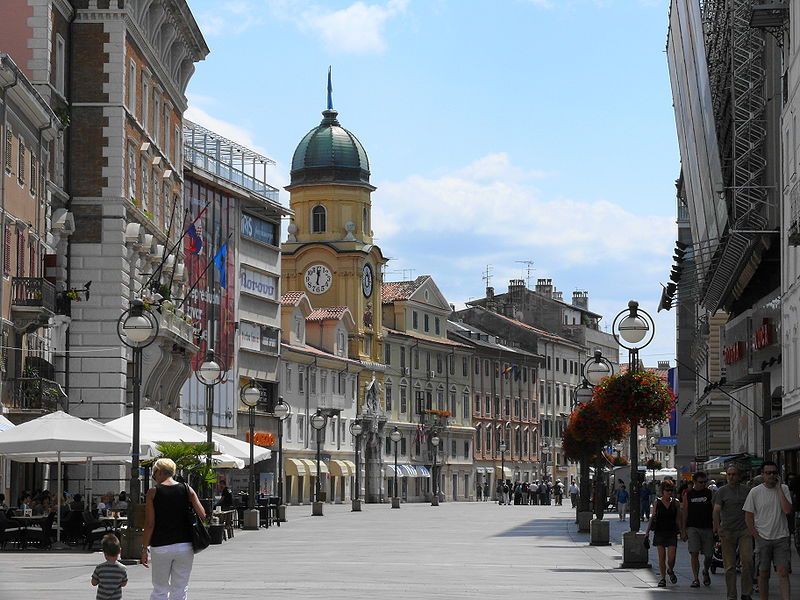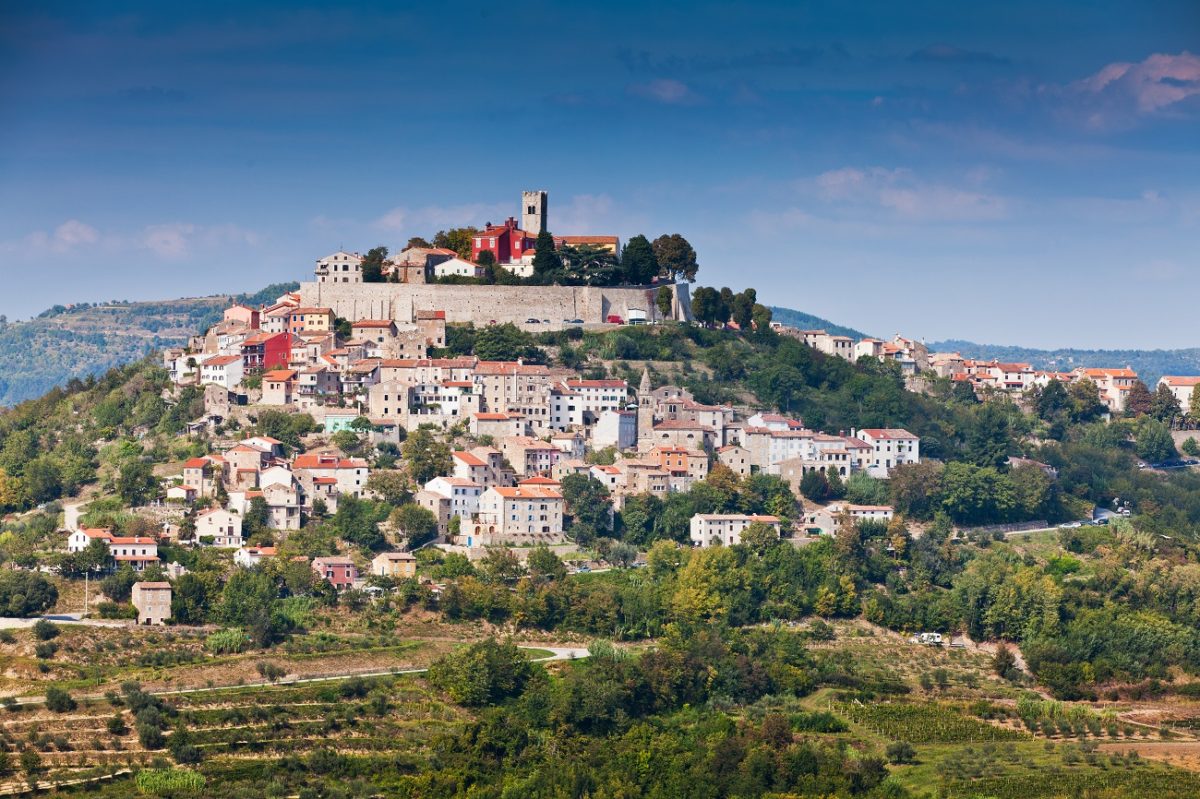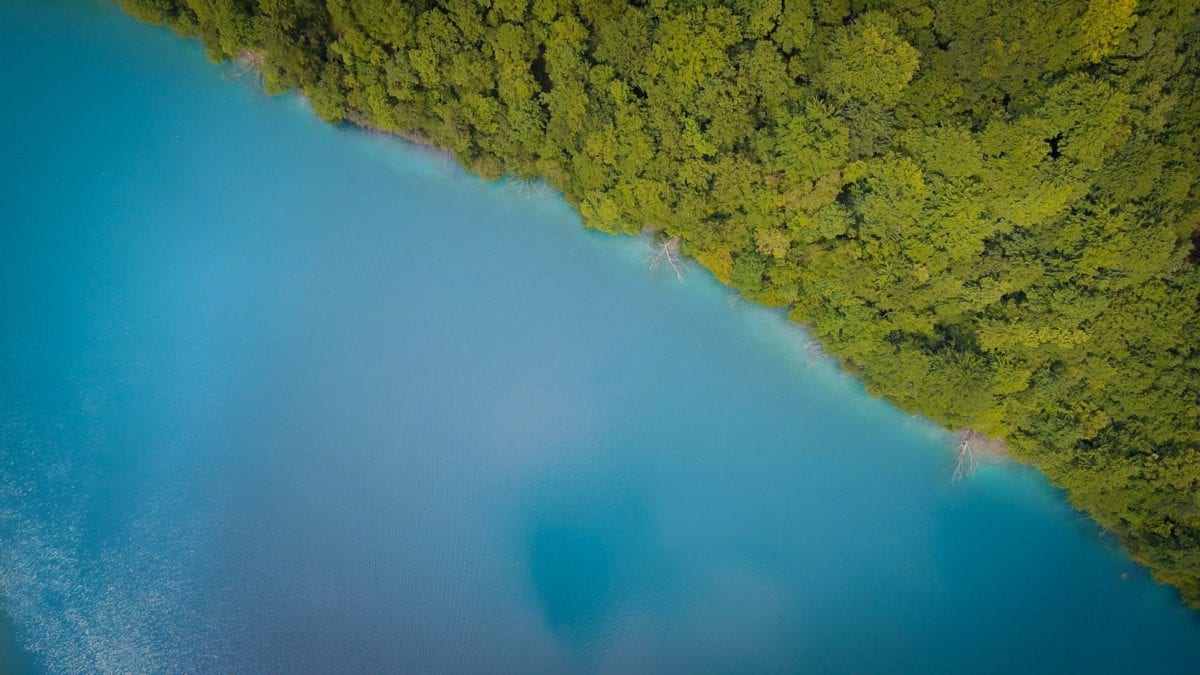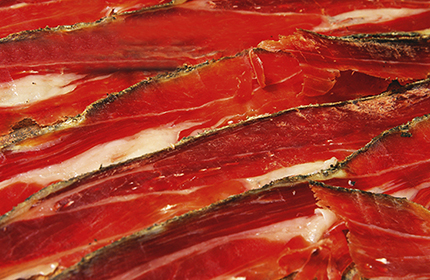Croatia is blessed with one of the most striking coastlines in the Mediterranean, but its diversity is what makes it truly special – from the glamour of Hvar and charm of Korčula to the wild, rugged beauty of Mljet and Lokrum. You’ll find spectacular mountain hiking trails, countless unspoilt national parks, a range of colourful festivals – and, of course, the mighty walls and medieval monasteries of Dubrovnik, Split and Zadar.
For more information, check out our guide to Croatia:
Food and drink in Croatia
What you eat and drink in Croatia will depend on where you are – in Slavonia, along the Hungarian border, you can expect to find spicy sausages and heavy, meaty soups, while along the coast you’ll find an Italian flavour to the food, with plentiful pizza, pasta and fish dishes, followed by lashings of ice cream. What you’re unlikely to find these days, sadly, is Hoppel Poppel on the menu. According to my trusty 1966 Gateway Guide, ‘Hoppel Poppel, which the visitor feels inclined to tackle straight away because the name sounds so amusing and exotic, turns out to be a well-known international dish – hash.’ Each region has its own wines and beers to be proud of, and across the country you’ll find a range of fearsome spirits, designed to warm the cockles and cement friendships.
Food
The day starts for most of us with breakfast, though it practically doesn’t exist as a meal per se in Croatia. If you’re in a hotel, however, then breakfast of some sort will invariably be included in the price – usually in the form of a self-service buffet, with the quality and variety of fare on offer closely correlating to the number of stars.
You’ll also find cheap restaurants and snack bars everywhere – often billed as bife (bar) or roštilj (grill bar) – serving up lunch or dinner of ćevapi or ćevapčići (spiced meatballs or small sausages, usually accompanied by spring onions and spicy green peppers), pljeskavica (a wad of minced meat often served in pitta bread – the Croatian hamburger), or ražnjići (kebab). Try any of these dishes with fiery ajvar, a sauce made from tomatoes, peppers and aubergines, with a dash of chilli.
Drink
The most important thing you need to know is that you can drink the water – all publicly supplied water is safe unless it explicitly says otherwise. The next piece of good news for drinkers is that alcohol is pretty inexpensive when compared to northern Europe, with a half-litre of draught beer (pivo) costing anything from 10 to 20kn, depending on the establishment. Premium brands go for a little more, but local beers are just great, my personal favourite being Karlovačko pivo, from Karlovac.
Health and Safety in Croatia
Health
The chances are you’ll never need them, but here are four phone numbers worth knowing: Tel: 92 for the police, 93 for fire, 94 for an ambulance and 9155 for search and rescue at sea.
There is no reciprocal healthcare agreement with EU countries, so make sure you have proper health insurance for major emergencies. Normally hospital treatment and some other medical and dental treatments are free. If you are travelling from the UK then you will need to show your passport, but if you are a UK resident but not a UK national then you will need a certificate of insurance from HM Customs Centre for Non-Residents.
If you have a pre-existing medical condition, are pregnant or are travelling with children then you would be wise to establish healthcare facilities before arriving in Croatia. Larger hotels and tour company representatives are often able to assist, but failing that then contact the nearest British embassy or consulate for advice. A list of clinics is also provided by the International Society of Travel Medicine and can be found on its website.
For minor treatment, a visit to one of the ubiquitous pharmacies (ljekarna) should sort you out, and there’s very often someone who speaks some English. For more serious problems, get yourself to a clinic or hospital (klinika or bolnica).
There are no legal requirements for vaccinations for Croatia, but most doctors would advise immunisation against diphtheria, tetanus and polio (given as an all-in-one ten-yearly vaccine – Revaxis), and hepatitis A (e.g. Havrix Monodose or Avaxim). For longer trips (four weeks or more), or for those working in the medical field or with children, vaccination against hepatitis B is advised. Ideally, a course of three injections is required, the minimum time for which is over 21 days if you are 16 or over. For younger travellers the minimum course of three vaccinations is over two months.
Similarly, a course of rabies injections (three doses over a minimum of three weeks) is advisable for those working with animals, or spending a longer time in Croatia. Tuberculosis (TB) is spread through close respiratory contact in crowded conditions and may occasionally be spread through infected milk and milk products. Experts differ over whether a BCG vaccination against tuberculosis is useful in adults; discuss with your travel clinic.
Travellers planning to go rambling or trekking in the countryside during the spring–autumn period are at risk of tick-borne encephalitis. The ticks that transmit this potentially fatal disease live in long grass and overhanging tree branches. Precautions include wearing long trousers tucked into boots, and a hat. Using tick repellents and checking for ticks at the end of the day can also help. If you do find ticks, remove them as soon as possible (see opposite) and go to a doctor for treatment. Pre-exposure vaccine is in short supply in the UK, but, if you do manage to track some down, it’s worth having. Three doses can be given over two weeks if time is short. However, it’s still important to seek medical help in the event of a tick bite. If you use needles for any reason, you should bring a doctor’s note explaining why, and if you wear contact lenses or glasses, bring spares; repairs and replacements aren’t a problem, but can take time. It also does no harm at all to have a doctor’s and dentist’s check-up before you go – far easier at home than abroad.
You can drink the water if it’s from a public supply; however, the mineral content may well be different so could cause stomach upsets. It is always safer to drink and clean your teeth with bottled water.
Travel clinics and health information
A full list of current travel clinic websites worldwide is available on www.istm.org. For other journey preparation information, consult www.travelhealthpro.org.uk (UK) or http://wwwnc.cdc.gov/travel/ (US). Information about various medications may be found on www.netdoctor.co.uk/travel. All advice found online should be used in conjunction with expert advice received prior to or during travel.
Safety
Croatia is safer and freer of crime than most EU countries, though the normal precautions you’d apply at home apply here, too – don’t be showy with money, jewellery or flashy possessions, and avoid the seedier or ill-lit parts of cities at night. You’re more likely to be robbed by fellow travellers than by Croats, so be especially careful in hostels, campsites and overnight trains or buses, and keep your valuables close to you and separate from the rest of your luggage.
Car theft, however, is increasingly prevalent, and foreign-registered cars – and especially expensive foreign-registered cars, such as Audis, BMWs and Mercedes – are attractive to thieves. Generally speaking, you wouldn’t expect problems along the coast, though be careful where you leave your car in any big city, and don’t leave your vehicle unattended for more than a day anywhere – it’s tantamount to painting a ‘Steal Me’ notice on it.
You’ll see lots of police around, and they have rather fearsome powers – freedom of dissension shouldn’t be taken for granted. The police carry out occasional spot checks on locals and foreigners alike for identification, so make sure you have your passport or identity card with you at all times. Otherwise, you’ll find the police friendly and helpful, though, apart from along the coast and in the capital, few speak any English.
If you’re driving, keep to the speed limits. There are an astonishing number of speed traps – especially along the Magistrala, the coast road running all the way from Opatija to Dubrovnik – and foreigners attract police attention. If you’re stopped for a traffic violation, you may find the police negotiate a lower penalty with you – the heavier fine for speeding, for example, may be traded down to the lower fine (payable in cash) for not wearing your seat belt.
Turning into a one-way street the wrong way in Dubrovnik, I was immediately stopped by the police and told to park the car in a spot reserved for the disabled. I was then given a choice of having my licence taken away and a 1,500kn fine (for driving the wrong way down a one-way street – unmarked as such, I might add), or paying the 150kn fine for parking in a disabled spot.
Travel and visas in Croatia
Visas
As of 01 January 2023 Croatia is part of the Schengen area.
You can travel to countries in the Schengen area for up to 90 days in any 180-day period without a visa. This applies if you travel as a tourist, to visit family or friends, to attend business meetings, cultural or sports events, or for short-term studies or training.
If you are travelling to Croatia and other Schengen countries without a visa, make sure your whole visit is within the 90-day limit. Visits to Schengen countries within the previous 180 days before you travel count towards your 90 days.
Full details of who does and doesn’t need a visa for Croatia, as well as up-to-date addresses and phone numbers of all the Croatia diplomatic missions worldwide – and foreign diplomatic missions in Croatia – can be found on the Ministry of Foreign Affairs’ website. Information about Schengen visas can be found here.
Getting there and away
By air
Flying to Croatia is easily the quickest way of arriving – Zagreb is just two hours from London, and Dubrovnik is only half an hour further. Both British Airways and Croatia Airlines fly to Croatia, though not always direct or every day – summer flights tend to be both direct and a good deal more frequent. Expect to pay anything between £100 and £500 for a scheduled return flight, including taxes.
By bus
Luxury coaches cruise between most cities in Europe, but it’s a long journey (London to Zagreb takes between 30 and 40 hours) and buses aren’t as cheap as they used to be (sample fares, without student discount, range from £120 upwards). That said, if you can get a discount, this may be a viable way to go.
By car
In spite of the long drive (London to Zagreb is 1,640km by road; London to Dubrovnik 2,175km) and the expense (tolls and fuel in Europe are pricey), having your own car in Croatia can certainly be an advantage, especially if you’re travelling as a family, or planning on moving around a great deal and wanting to visit remote places. Unless you’re wedded to the idea of touring in your own vehicle, it can be much more cost effective to rent a car once you get there rather than take your own, and all the big companies have agencies in the main cities and airports. If you’re doing this, make sure you book the car before you arrive in Croatia, as it’s much more expensive once you get there if you haven’t reserved ahead. Note that traffic on the coast can be extremely busy in the summer.
By boat
You can travel across and up and down the Adriatic on one of the many ferries that ply the Croatian coast all the way from Pula and Rijeka in the north to Split and Dubrovnik in the south. The ferries are a slow but very attractive way of getting around, and a reminder of the only way people travelled any distance here as recently as the 1930s. The are now several companies plying the Adriatic between Italy and Croatia, including: Jadrolinija between Ancona and Split, Ancona and Zadar, and Bari and Dubrovnik; Sanmar between Pescara, Hvar and Split; SNAV from Pescara to Hvar and Vela Luka; Trieste Lines from Trieste to Rovinj and Pula; and Venezia Lines between Venice and Poreč, Rovinj, Pula and Mali Lošinj.
Getting around
You can get around Croatia by plane, train, bus, car, bicycle and hitchhiking – or on foot – and around the Adriatic by ferry, or on your own (or a rented) boat. The train network is good to points connected to Zagreb, but poor (non-existent) along much of the coast, where you’ll find yourself on the ubiquitous buses or ferries. Public transport is regular, effective and good value for money, but can be slow and is sometimes overcrowded – notably in summer.
By air
Croatia Airlines’ domestic flights are pretty good value, and a great way of getting from one end of the country to the other, especially if you’ve already seen it all from the bus.
By rail
Trains have greatly improved in the past decade, and cover the north and east of the country fairly comprehensively. They’re about the same price as buses or slightly cheaper, for any given distance, but can be faster (inter-city, brzi) or slower (local trains, putnički). Trains can get very crowded, especially in summer, but they tend to be reasonably punctual. Local trains (the ones not marked in red on timetables) are usually much less crowded, and much less punctual. The high-speed line between Zagreb and Split has been dogged with problems (including a major accident in 2009), but has reduced the journey time between the two cities to around 5½ hours.
By bus
The bus network is wide-ranging, reliable and regular, and operated – as in Switzerland – by a well-organised federated system of interconnected small companies. Buses offer the best way of coming into contact with local people, and are the only way of travelling on public transport along the coast and on the islands.
By car
The most comfortable and often quickest way of travelling is by car, and sometimes it’s the only way to get somewhere really remote. Road quality has improved enormously in the 25-odd years since I first drove in Croatia, and there are now several good sections of motorway open – you’ll pay tolls on these, though they’re not excessive.
When to visit Croatia
High summer is a great time to be in the higher parks, such as Risnjak, in the north, or to visit the capital and other towns away from the coast, as lots of locals are themselves on holiday then. But bear in mind that inland Croatia can get pretty hot and sweaty in the absence of sea breezes – and you’ll need to book tickets on public transport in advance.
If you have a choice, September is the best month to be on the coast or visit the islands. The weather is fine, the school holidays are over and the sea is still easily warm enough for swimming. October is also fine, but by November the sunshine hours are down and the rainfall hours up. May and early June, too, are absolutely gorgeous along the coast, though there’s an increasing tendency for accommodation and ferries to fill up as June progresses.
September and June are the best months for walkers and hikers, closely followed by October and May, and autumn in the inland parks provides stunning visuals as the leaves change colour. Earlier than May and you may find it damp in the lowlands and freezing higher up; later than October and you run the risk of being caught by the first snows.
Yachting, sailing and motor-cruising have a season running from the beginning of May to the first week of October. Outside this period, charters won’t be possible and you’ll find the weather in any case less pleasant, with a more frequent gale-force bura (the gusty northeasterly wind that can blow at gale-force from September to May for anything from four days to a fortnight).
July and August are easily the most popular months with all types of visitor, so you may want to leave well alone, unless you’re absolutely set on clubbing, or that deep suntan. These are the months when you’ll be competing for rooms with up to six million others, and, if you’re travelling by car, you’ll find parking a hassle, and queues for the car ferries measured in hours. That said, July and August are easily the best months for being on the beach, and Croatia’s coastal nightlife only really comes alive in summer.
If you’re not bothered by the damp and cold, winter is a great time for cultural exploration – the coast and islands are deserted and you’ll have museums and churches to yourself. Waiters and hoteliers will be delighted you’re there rather than hassled by the next customer, and while you may have to wait a day for the next ferry, you won’t have to queue. If you’re in inland Croatia in winter, however, do wrap up warm. Finally, if you’re planning winter trips to any islands, especially the smaller and remoter ones, bear in mind that from November until Easter they’re simply not expecting you. That means accommodation can be hard or impossible to find and restaurants may be closed for the duration – check ahead before you catch the ferry.
What to see and do in Croatia
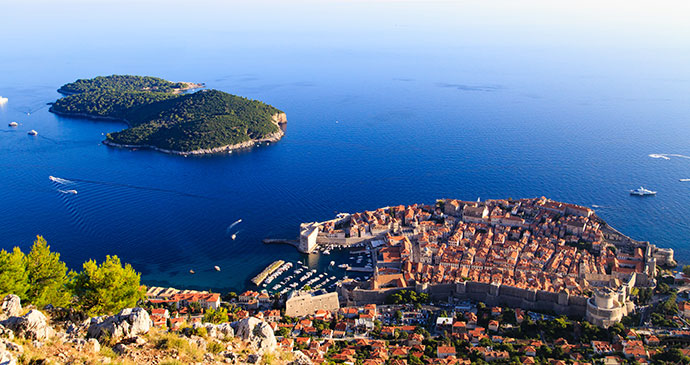 The UNESCO-listed walled city of Dubrovnik, just a short boat ride from the haven of Lokrum © Nadezhda1906, Shutterstock
The UNESCO-listed walled city of Dubrovnik, just a short boat ride from the haven of Lokrum © Nadezhda1906, Shutterstock
Dubrovnik
The biggest draw in Southern Dalmatia is the extraordinary walled city of Dubrovnik. Vast walls, up to 25m high, come complete with fortresses, towers, crenellations and an ancient footpath along the entire 2km extent. The streets are paved with time-polished pale marble, with the town’s harmony owing as much to the 17th-century rebuilding programme following the Great Earthquake in 1667 as it does to Dubrovnik’s remarkable history, stretching back well over 1,000 years.
Of course Byron’s ‘Pearl of the Adriatic’ is no secret, with nearly half a million people a year staying at least one night, and even more coming in for the day on 440-odd foreign cruise ships every year. Nevertheless the city copes admirably with the influxes, and you’ll find a place full of cheerful cafés, bars and restaurants, wonderful architecture, intriguing museums, atmospheric churches and a world-famous summer festival. The entire old city is a UNESCO World Heritage Site.
As if that weren’t enough, Dubrovnik is blessed with an especially kind climate. Winter daily maximums rarely fall below 12°C, the sun shines reliably right through the summer, and there are plenty of beaches, with swimming popular from May to October. The city even has its own perfect forested island, Lokrum, just a few hundred metres offshore.
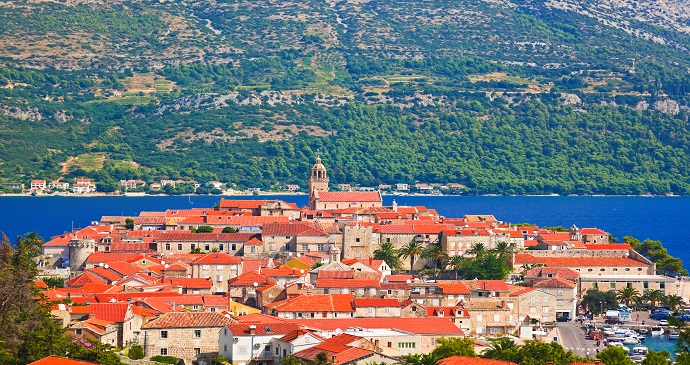 © Tatiana Popova, Shutterstock
© Tatiana Popova, Shutterstock
Korčula
Like Hvar, Korčula has a lovely old town and lots of hard-to-reach coves and beaches. Like Hvar, too, Korčula’s no secret, but it doesn’t have nearly the visitor numbers of its northern neighbour (though Korčula’s numbers are growing significantly faster, year on year). The island is nestled up to the western end of Pelješac (less than 1.5km of sea separates them at the narrowest point) and stretches about 45km west into the Adriatic. On average it’s about 6km across, from north to south, and has a mountainous spine rising to 568m just west of the village of Pupnat. The main attraction on the island is the old town of Korčula itself, though a close second has to be Korčula’s powerful white wines.
Mljet National Park
Mljet is one of the most attractive islands in the whole Adriatic. Despite being unusually beautiful, and entirely unspoiled by deforestation (it was never ruled by Venice, hence also the lack of towns of any size), it has hitherto remained relatively unvisited – though with the fast connection from Dubrovnik more people are coming every year. Nonetheless, the island is easily big enough, at over 100km², to absorb many more visitors without getting overcrowded.
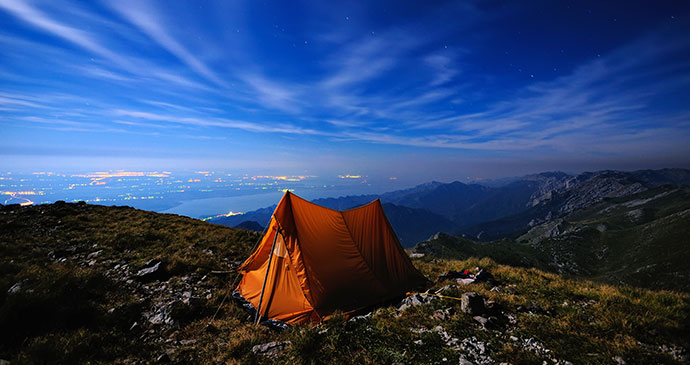
Camping in North Velebit National Park © Croatian National Tourist Board
North Velebit National Park
The Velebit range – covering 2,000km² and stretching over 100km from Senj to Zadar – contains two national parks, Paklenica, to the south, and North Velebit, between Senj and Karlobag, to the north. Of the two, North Velebit is the more remote, and far and away the least visited – it only achieved national park status in 1999, and development of any tourist infrastructure is still in its relative infancy. You can reach the Zavižan and Alan mountain huts by minor roads, and there are marked hiking trails to both these and other points from the coast.
The park is home to the notoriously people-shy brown bear, wild boar, lynx, wild cats, red and roe deer and several species of eagle; a wide range of rare and protected plant species; and one of the fifteen deepest caves in the world.
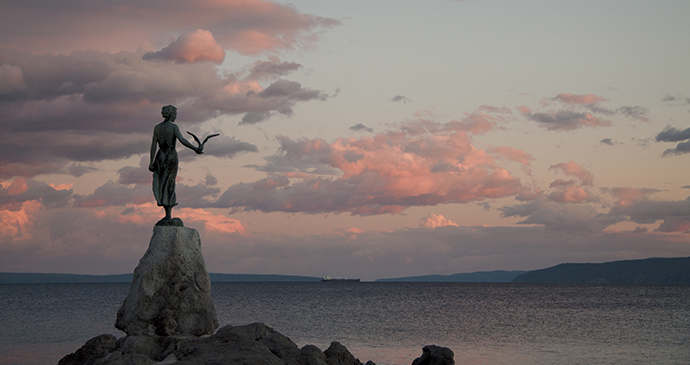 Maiden with a Seagull is one of Opatija’s most famous sites © Opatija riviera Photonet
Maiden with a Seagull is one of Opatija’s most famous sites © Opatija riviera Photonet
Opatija
A mere fishing village 200 years ago, Opatija became the first spa resort on the entire Croatian coast. Largely only for the rich, privileged and noble 150 years ago, it still has, as a result, what must be the highest concentration of high-end spa hotels in Croatia, especially for its size. These hotels and villas alone are worth a stroll along the 12km promenade. Opatija hides a few more gems, including its botanical gardens Benedictine abbey of St James, the medieval fort at Veprinac and – just a short stroll along the coast at one end of that lovely promenade – the pre-eminent gastro-enclave anywhere in Croatia, at the sleepy little fishing village of Volosko.
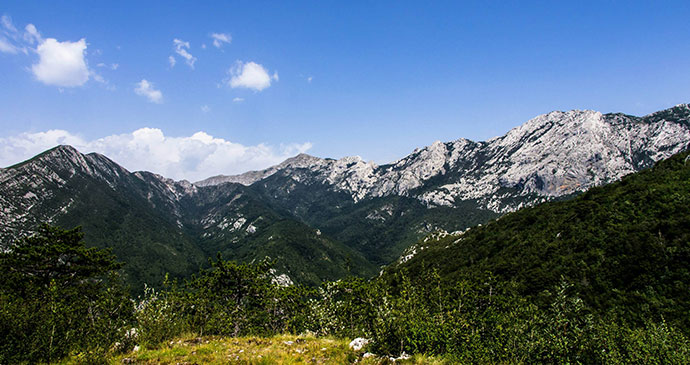 © Adrian Chan
© Adrian Chan
Paklenica National Park
Situated halfway between Karlobag and Zadar – an hour from either, by bus – is Paklenica National Park, a pair of wonderful limestone gorges running up from the sea, deep into the Velebit massif. Popular with Croatian walkers and climbers, it’s also one of my favourite places in the whole country, offering everything from a gentle stroll to a seriously strenuous trek, and pitches for rock climbers of every level.
Walking is possible from sea level up to the top of the massif. Most of the lower reaches are heavily forested with deciduous trees, while higher up mountain pastures support sub-alpine flowers and herbs. One of the most attractive features of the park, however, is the more than 80 species of butterfly found here, making it a lepidopterist’s paradise.
There are also lots of beetles and several reptiles (you’ll see snakes slithering off the path as you approach) and amphibians, and an extraordinary 209 species of bird to watch out for.
Plitvice Lakes National Park
Croatia’s best-known and most-visited natural attraction– and a UNESCO World Heritage site since 1979 – is the Plitvice Lakes National Park. Covering a total of nearly 300km², the prize here is 16 lakes, falling from one to the next in a series of gushing waterfalls. The lakes are set in deep forests still populated by bears, wolves and wild boar, and are all the more unusual for being found in the middle of a typically dry karst region, where surface water is extremely rare.
The national park has been very carefully exploited, and although it can get busy the crowds are rarely intolerable. The routes are often carried along attractive wooden walkways avoiding erosion and allowing people to walk over, under, across and alongside the waterfalls, and around the lakes.
The combination of running water and altitude makes the park wonderfully refreshing almost all through the summer, although it can be cold and gloomy – not to mention frozen solid – in winter (but you’ll have the place largely to yourself, and the waterfalls turn into curtains of icicles). April and October are the best times to visit – the former with the water flow increased by melting snows, and the latter with the deciduous woods enriched with fabulous autumn colours.
Roman amphitheatre at Pula
Pula (Pola) has been continuously inhabited for the past 3,000 years. What you’ll find today, however, is a whole clutch of superb Roman ruins (including ) set in a cheerful, cosmopolitan, street-café city of 65,000 people. Pula lives on the fence, caught halfway between its shipyard, docks and busy commercial port, and the beaches, coves and tourist developments strung out along the indented peninsula a couple of kilometres south of the centre.
You can’t miss Pula’s enormous Roman Amphitheatre – it’s the sixth biggest in the world (after Rome, Capua, Verona, Syracuse and Arles, since you ask), and has the most complete outer walls of any still standing. Started under Augustus, and continued under Flavian, it was enlarged and completed to its present 130m-by-105m ellipse under Vespasian (whose lover Antonia, it’s said, came from Pula) in the second half of the 1st century AD.
Rovinj
Rovinj’s (Rovigno’s) main attraction is itself – the charming narrow cobbled streets running up through the warren of the old town, the paved car-free quays, the Venetian palazzi and medieval houses, and the 30-odd churches within the old town walls, some so small you ‘d never know they are there. Serious tourist development is encroaching on this photogenic, once-upon-a-time island city, but it still manages to accommodate increasing numbers of visitors with ease – mostly away from the old town, along the coast or on one of the nearby islands.
It’s also the most Italian place in Croatia, with the people, street signs and menus all being bilingual. A centuries-old fishing tradition is alive and well, though on the wide quaysides you’re as likely to witness spontaneous concerts or vibrant café life as fishermen bringing in the catch or mending their nets.
Split
Spreading out from the peristyle, the streets of the old town of Split were once palatial corridors and the houses huge reception rooms for the former Roman emperor in retirement.
Croatia’s second biggest city is a brash and captivatingly energetic hub, with a population of over 200,000 – but the old centre is surprisingly compact and easily manageable on foot. The main draw is Diocletian’s Roman palace, just along the Riva from the port where you’re likely to arrive – still stunning after more than 1,700 years of builders’ alterations. Diocletian no doubt had a monster ego (being emperor has that effect), but even he can’t have imagined his home would be so well worth visiting in the 3rd millennium.
In its heyday the palace must have been extraordinary. At over 30,000m², it included everything from vast reception chambers to temples, arcaded corridors, baths, huge storerooms, extensive private apartments and an entire barracks. No expense was spared in its construction, with materials shipped in from Egypt and Greece, though it was built in a terrible rush, as it had to be ready for the emperor’s retirement.
Zagreb
Rebecca West sized up Croatia’s capital nicely when she was here in 1937: ‘Zagreb makes from its featureless handsomeness something that pleases like a Schubert song, a delight that begins quietly and never definitely ends. It has the endearing characteristic noticeable in many French towns of remaining a small town when it is in fact quite large.’ Indeed, today, with a population of a million, Zagreb is easily Croatia’s largest and most cosmopolitan city, though the centre is still agreeably manageable on foot.
Zagreb’s heart is a fine, clean example of solid Habsburg architecture, tending towards palatial elegance, and large squares from which to view it – though if you move away from the city centre you’ll find sprawling suburbs and high rises, thrown up to accommodate waves of incoming workers over the past 60 years.
For more than six months of the year Zagreb is a lively outdoor city, with café tables spilling out across the pavements and flowers everywhere. In winter it can be cold and a bit oppressive, with snow on the ground for an average of over 50 days annually and the streets of the lower town seeming too large for their occupants – but with a big university and heaps of bars, clubs and nightlife on offer, the locals certainly know how to have a good time. The city is also particularly strong on classical culture, with regular opera, ballet, theatre and musical performances of international standard.
As the capital, Zagreb is well served by both international and domestic transport routes, and has an international airport, as well as major rail and bus terminals.
Lonjsko Polje swamplands
Downstream from Sisak, the River Sava meanders slowly through the great marshy swamplands of the Lonjsko Polje. Prone to frequent flooding (the Sava can rise by up to 10m) and full of fish, the area is hugely popular with migrating birds, and especially with storks. The reedy shores of the oxbow lakes make for excellent nesting grounds for wading birds such as white egrets, grey herons and spoonbills.
Spotted Turopolje pigs root through the flooded oak forests (or at least they once did – most of the pigs you see now are not purebreds, which are increasingly rare), while dark, chunky Posavina horses – protected, and seen only in this region – graze in the summer pastures. Rustic villages preserve traditional oak houses, with barns on the ground floor and external wooden stairs leading to the living accommodation upstairs. It’s a rare chance to see a landscape that was once common across central Europe, and is on the tentative list of UNESCO World Heritage Sites.
Veliki Risnjak/Risnjak National Park
Only 15km from Rijeka as the crow flies, Risnjak National Park is a wonderful place to come in late spring and summer, with great walking, lovely flowers, spectacular scenery, and a relatively easy peak to scale. The weather can be extreme here, however, with the park affected by four different types of climate – harsh alpine, Dinaric mountain, mild Adriatic and continental Pannonian. In autumn it tends towards the very wet indeed, and in winter there’s a good deal of snow – at the Risnjak mountain hut, at 1,418m, there’s snow on the ground for an average of 157 days a year, and it can be up to 4m deep – though this can be a beautiful time to hike in the area, for those suitably equipped.
Related books
For more information, see our guide to Croatia:
Related articles
In this extract from her book, My Family and Other Enemies, Mary Novakovich recalls meeting family in Croatia for the first and only time.
Home to grand Secessionist architecture, broad pedestrian streets and excellent restaurants, Rijeka is well-deserving of its reputation as Croatia’s cultural capital.
Enter a world of perfectly preserved medieval hill towns, hidden frescoes and heavenly food.
There are many national parks in Europe that remain fairly unknown. Here you can discover 14 of the best. Why miss out on visiting somewhere spectacular?
One of the best reasons to visit Istria is the region’s outstanding cuisine.
